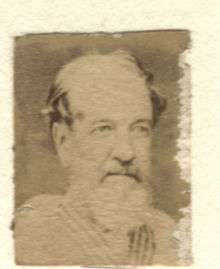Charles St Julian
| Sir Charles St Julian | |
|---|---|
 | |
| 1st Chief Justice of Fiji | |
|
In office 1872 – 27 August 1874 | |
| Monarch | Seru Epenisa Cakobau |
| Preceded by |
Charles Rossiter Forwood (acting) |
| Succeeded by | Sir William Hackett |
| Personal details | |
| Born |
Charles Trout 10 May 1819 France |
| Died |
26 November 1874 (aged 55) Nairu kuni, near Levuka, Fiji |
| Resting place | Nautolu Cemetery, Ovalau |
| Citizenship | British |
| Spouse(s) |
1. Eleanor Heffernan (26 November 1839 — 28 August 1861, her death) 2. Eliza Winifred Hawkesley (10 January 1863 — 26 November 1874, his death) |
| Children | 9 daughters, 6 sons[1] |
| Profession | Journalist, editor |
| Religion | Roman Catholicism[2] |
Charles James Herbert de Courcy St Julian (10 May 1819 – 26 November 1874) was a journalist, newspaper owner-editor and the first Chief Justice of Fiji.[3]
St Julian's obituary records that he was born in France but other sources suggest London in 1818,.[4] He claimed to be the son of Thomas St Julian, French army officer, and his wife Marian, née Blackwell. However, the Australian academic, Marion Diamond, in her biography of St Julian, claims that he deliberately obscured his origins and that it is likely that his real name was Charles Trout and that his initial training was as a wood and ivory carver.[5]
St Julian emigrated to Adelaide in 1837, proceeding in 1839 to Sydney, where he wrote for the Australian Chronicle, and subsequently for the Commercial Journal.[6] In 1843 he joined the staff of the Sydney Morning Herald, which he left four years later for the Sydney Chronicle, afterwards known as the Free Press. In 1849 he rejoined the Herald.
St Julian participated in municipal politics, serving on the Waverley council in 1860 and as its chairman in 1861. He went on to serve as an alderman on the Marrickville Borough Council from 1868 to 1871, and as Mayor from 1868-1869 and again in 1871. In February 1870, he became a magistrate.[7]
St. Julian remained as Law Reporter for the Herald until 1872, when King Seru Epenisa Cakobau appointed him Chief Justice of Fiji. When Fiji became a British colony in 1874, Governor Sir Hercules Robinson proposed an annual pension of £200 for him,[8] but he died near Levuka, Fiji on 26 November 1874.[6]
Personal life
St Julian was a Roman Catholic. He married Eleanor Heffernan at St Mary's Cathedral, Sydney on 26 November 1839. She died on 28 August 1861. On 10 January 1863, he remarried, to Eliza Winifred Hawkesley, the daughter of the radical editor of the People's Advocate and New South Wales Vindicator, Edward John Hawksley.[9] Altogether, he had fifteen children — nine with Eleanor and six with Eliza.[1]
References
- 1 2 "SIR CHARLES Janies Herbert De Coucy St. Julian". Geni. Retrieved 1 November 2015.
- ↑ Lyons, Mark; Nothing, Marion. "St Julian, Charles James Herbert de Courcy (1819–1874)". Australian Dictionary of Biography. Retrieved 1 November 2015.
- ↑ Lyons, Mark; Nothing, Marion. "St Julian, Charles James Herbert de Courcy (1819–1874)". Australian Dictionary of Biography. Retrieved 1 November 2015.
- ↑ "Death of the late Chief Justice of Fiji.". The Sydney Morning Herald. N.S.W.: National Library of Australia. 22 December 1874. p. 5. Retrieved 26 August 2014.
- ↑ Diamond, Marion (1990). Creative Meddler, The Life and Fantasies of Charles St Julian. Melbourne: Melbourne University Press. p. 5. ISBN 0522844235.
- 1 2 Mennell, Philip (1892). "
 St. Julian, Charles James Herbert". The Dictionary of Australasian Biography. London: Hutchinson & Co. Wikisource
St. Julian, Charles James Herbert". The Dictionary of Australasian Biography. London: Hutchinson & Co. Wikisource - ↑ Lyons, Mark; Nothing, Marion. "St Julian, Charles James Herbert de Courcy (1819–1874)". Australian Dictionary of Biography. Retrieved 1 November 2015.
- ↑ Great Britain, Parliament., House of Commons. "Sir Hercules Robinson, K.C.M.G., to the Earl of Carnavon". Accounts and Papers of the House of Commons, Volume 52. Retrieved 1 November 2015.
- ↑ Lyons, Mark; Nothing, Marion. "St Julian, Charles James Herbert de Courcy (1819–1874)". Australian Dictionary of Biography. Retrieved 1 November 2015.
